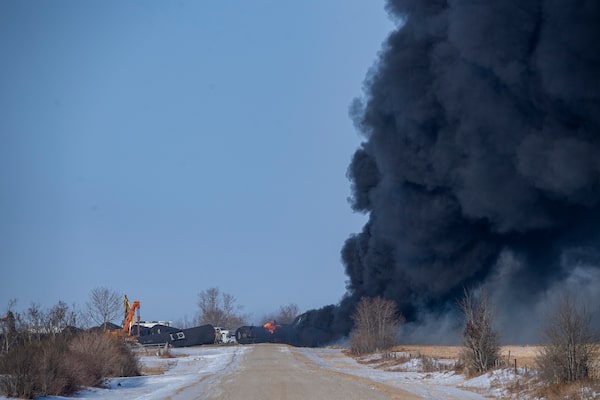
Emergency crew respond to CP Rail train hauling crude oil that derailed near Guernsey, Sask. on Monday, December 9, 2019.Liam Richards/The Canadian Press
Soaring flames and a thick plume of smoke followed the derailment of a Canadian Pacific Railway train carrying crude oil across central Saskatchewan – a crash that comes as Alberta’s government looks to boost oil-by-rail shipments.
The fiery derailment around midnight on Sunday didn’t cause any injuries but led to a tangle of train cars burning alongside a highway about 120 kilometres east of Saskatoon. The fire continued to burn on Monday evening as federal investigators arrived near the community of Guernsey.
Melanie Loessl woke up at about 1:45 a.m. on Monday as firefighters began to fight the blaze, with rail cars on fire near the end of her driveway. “You could hear the hissing and noise from the cars that were on fire and there was just an enormous amount of flames. You couldn't imagine it,” she said.
As acrid smoke filled the air, Ms. Loessl was asked to evacuate for a few hours but returned before dawn. The RCMP shut down a highway in Saskatchewan owing to the thick smoke. The highway was still closed on Monday evening.
“At the end of my driveway, I cannot look across to the east because the smoke is so black you cannot see anything,” Ms. Loessl said.
CP and Canada’s Transportation Safety Board could not confirm on Monday how many rail cars had derailed or where the oil in the cars came from. Federal investigators will not enter the crash site until the fire is extinguished and dangerous materials are secured.
“Crews are working diligently and will ensure the area is cleaned up and restored after we safely recover from this incident,” CP spokesman Andy Cummings said in a statement. The railway says there was no impact to any waterway.
There have been a number of derailments across North America that have seen oil cars catch fire since the 2013 disaster in Lac-Mégantic when an unattended train carrying 74 oil cars derailed in the small Quebec town. That crash killed 47 people and destroyed the core of the once picturesque lakeside town. The disaster also brought the growing volume of oil moving on the rails to the attention of regulators in Ottawa.
After the Lac-Mégantic derailment, the federal government announced that railways would need to carry more insurance, begin using sturdier rail cars to transport oil and could no longer use single-person crews.
The amount of oil being transported by railways has nearly doubled since the crash in Lac-Mégantic, owing in part to the lack of pipeline capacity in Canada as production in Alberta’s oil patch has continued to increase. Nearly 320,000 barrels of oil were exported daily by rail in September, according to the latest figures available from the Canada Energy Regulator.
The volume of oil being carried by railways could grow further in the coming months. The Alberta government began allowing oil producers to increase their production levels above the province’s quotas on Dec. 1, as long as the additional oil is transported by rail.
Production quotas were introduced in the final weeks of 2018 by the former NDP government of Rachel Notley as a lack of pipeline capacity was causing the price paid for Alberta’s oil to plummet on international markets. Alberta Premier Jason Kenney’s government has been looking for ways to relax the quotas by shifting more oil to rail cars.
In a statement in October when the new rail program was announced, Alberta Energy Minister Sonya Savage said moving more oil by train would increase production. “The special allowance program will protect the value of our oil by ensuring that operators are only producing what they are able to move to market,” she said at the time.
The Alberta government is also looking to sell nearly $3.7-billion in crude-by-rail contracts for 4,400 rail cars. The contracts were signed by the Notley government to increase the amount of oil moving by rail.
With reports from The Canadian Press
We have a weekly Western Canada newsletter written by our B.C. and Alberta bureau chiefs, providing a comprehensive package of the news you need to know about the region and its place in the issues facing Canada. Sign up today.